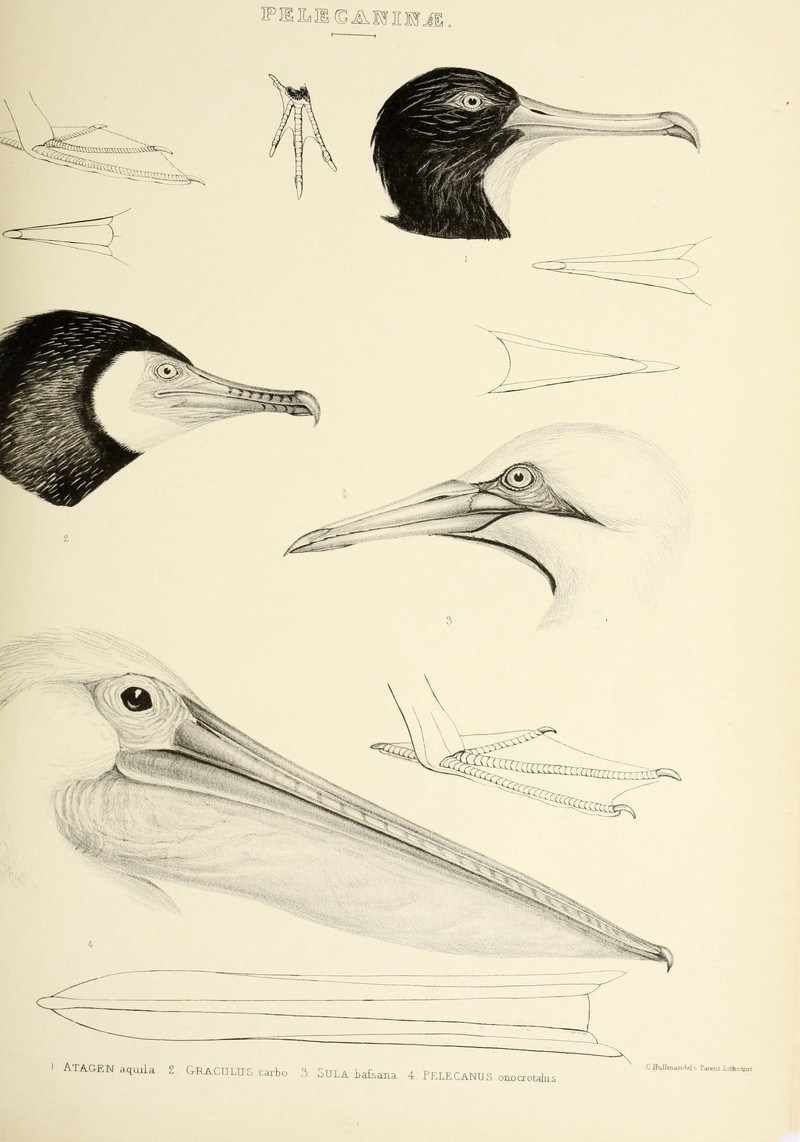|
| 질의: Birds of america | 결과: 203번째/1888 | |
Atagen aquila = Fregata aquila (Ascension frigatebird), Graculus carbo = Phalacrocorax carbo (great cormorant), Sula bafsana = Sula bassana = Morus bassanus (northern gannet), Pelecanus onocrotalus = Pelecanus onocrotalus (great white pelican)
| 제목: | Atagen aquila = Fregata aquila (Ascension frigatebird), Graculus carbo = Phalacrocorax carbo (great cormorant), Sula bafsana = Sula bassana = Morus bassanus (northern gannet), Pelecanus onocrotalus = Pelecanus onocrotalus (great white pelican)
| | 올린이: | Wiki Photos (---@---.---)
| |

| 해상도: 1637x2337
파일크기: 352786 Bytes
등록시간: 2023:04:29 13:02:38
|
PELECANINAE
1. Atagen aquila = Fregata aquila (Ascension frigatebird)
2. Graculus carbo = Phalacrocorax carbo (great cormorant)
3. Sula bafsana = Sula bassana = Morus bassanus (northern gannet)
4. Pelecanus onocrotalus = Pelecanus onocrotalus (great white pelican)
Date 1849
Source https://www.flickr.com/photos/biodivlibrary/19140629060
Author George Robert Gray; Hullmandel & Walton; Charles Joseph Hullmandel; D. W. Mitchell
Full title The genera of birds : comprising their generic characters, a notice of the habits of each genus, and an extensive list of species referred to their several genera /
Source: https://commons.wikimedia.org/wiki/File%3AThe_genera_of_birds_%2819140629060%29.jpg
1. Atagen aquila = Fregata aquila (Ascension frigatebird)
The Ascension frigatebird (Fregata aquila) is a seabird of the frigatebird family Fregatidae which breeds on Boatswain Bird Island and Ascension Island in the tropical Atlantic Ocean. The Ascension frigatebird is a large lightly built seabird with brownish-black plumage and a deeply forked tail.
2. Graculus carbo = Phalacrocorax carbo (great cormorant)
The great cormorant (Phalacrocorax carbo), known as the black shag or kawau in New Zealand, formerly also known as the great black cormorant across the Northern Hemisphere, the black cormorant in Australia, and the large cormorant in India, is a widespread member of the cormorant family of seabirds (Phalacrocoracidae). The great cormorants breed in much of the Old World, Australia, and the Atlantic coast of North America.
3. Sula bafsana = Sula bassana = Morus bassanus (northern gannet)
The northern gannet (Morus bassanus) is a seabird, the largest species of the gannet family, Sulidae. It is native to the coasts of the Atlantic Ocean, breeding in Western Europe and Northeastern North America. It is the largest seabird in the northern Atlantic.
4. Pelecanus onocrotalus = Pelecanus onocrotalus (great white pelican)
The great white pelican (Pelecanus onocrotalus) also known as the eastern white pelican, rosy pelican or white pelican is a bird in the pelican family. It breeds from southeastern Europe through Asia and Africa, in swamps and shallow lakes. |
^o^
동물그림창고 똑똑전화 누리집
^o^
|
|